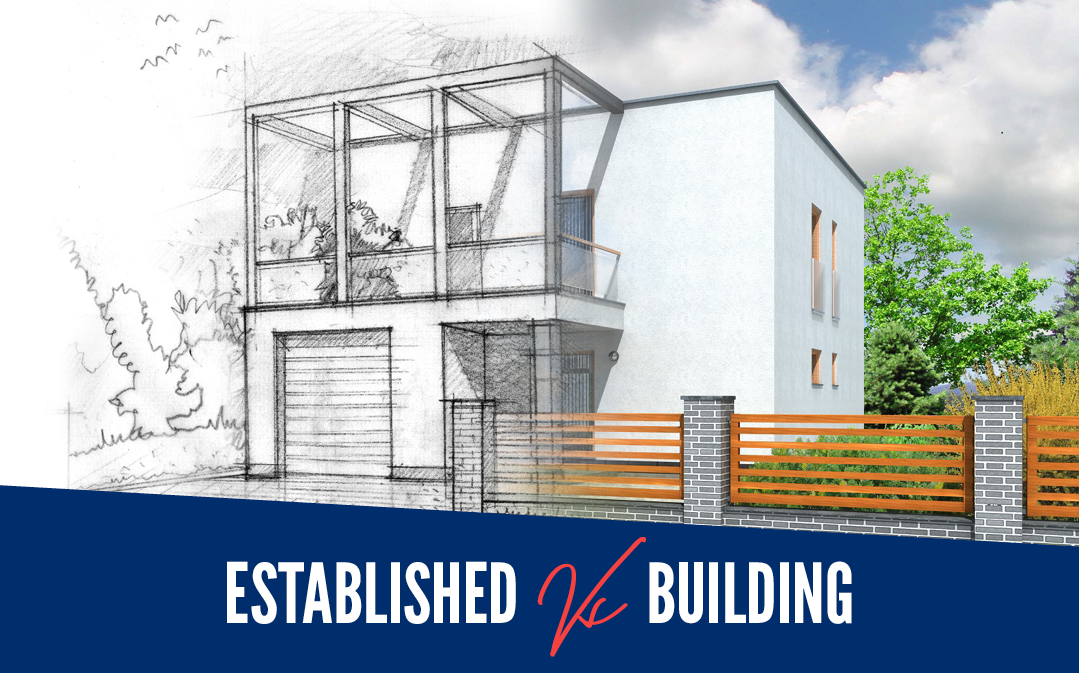New or established, what’s best at the moment (ATM) ?
There’s a lot to consider when it comes to investing in property. What the overall property market’s like, the predicted market trends in the area you’re thinking of investing in, whether the numbers stack up and so on. In Australia, we’ve been mostly lucky that the property market has been a lucrative investment option and one of the most popular ways to create long-term wealth and financial security.
But when it comes to property investment, particularly as a member of the Australian Defence Force, one of the most important decisions you need to make is whether to buy an established property or build a new one. In this blog post we’ll discuss the pros and cons and help you decide what’s best; buying established vs building ATM?
As ex-ADF members ourselves, we’ve been in your boots and will help you make informed decisions so you can choose the best property investment type to suit your circumstances. Our property investment experts at Capital Properties invite you to attend our free Capital Properties Discovery Session to learn more. It might just be the best decision you ever make.
On the go? Here’s 30 seconds of take outs:
- An established property is a house that’s already been built and is ready to live in.
- The pros for buying an established property for investment purposes are: instant income, location & cost efficacy.
- The cons of buying an established property are greater overall upkeep, depreciation of value & limited design input.
- Pros of building a new property for investment are: customisable design, lower maintenance costs & tax benefits.
- The cons of building a new property are: higher initial costs, delayed income & uncertain market conditions.
Keep reading >>
What’s an established property?
When we talk about an established property, we mean a property that’s already been built and is ready to live in. That might be an older home that requires some renovation, or a newer house that might need some superficial repairs. There are pros and cons to purchasing an established property for investment purposes.
Pros of buying an established property for investment
The goal for property investors is to purchase a property that will deliver a strong rental income while the property appreciates in value over time to deliver capital gains. In many ways, an established property can deliver on these objectives. Let’s take a look at the pros of buying an established property for investment.
Instant income
For the most part, an established property is ready for occupancy within a short amount of time. Even if renovations or repairs are required, there’s far more surety around the timelines of having that work done and finished. That means you can get a tenant into the property asap and start generating rental income almost immediately.
– Location
Choosing the right location to invest in is always one of the biggest considerations for successful property investment. Buying an established property means that you’re usually looking in a well-established area. We know that renters look for neighbourhoods that offer amenities such as schools, retail and entertainment facilities, parks, and public transport. We discussed the trend towards lifestyle culture in the blog post “The big shift in Australian demographics”.
That means that buying in an area that offers this lifestyle will attract reliable rental income and capital growth over the long term.
– Cost effective
Older properties in an established location are often priced lower than newer properties in the same location due to their age and condition. That’s assuming the property doesn’t need substantial renovation and you can move the tenant in quickly. And, of course, that it still appeals to the type of tenants you’re hoping to attract.
Cons of buying an established property
As with all decisions, it’s important to consider all sides of the story. Here’s some of the cons of buying an established property for investment.
– Greater upkeep
With an older property, there’s always going to be more maintenance and repairs required than in a new property. That means you’ll have to spend more money on renovations, as well as deal with the hassle having to organise the work and/or negotiate what needs to be done with the Property Manager.
As ADF members, we know that added hassle is the last thing you need. Repairs and miscellaneous costs can also eat into your rental income and reduce your profit margins.
– Depreciation of value
To calculate depreciation, we divide the value of the property by its useful life which is 27.5 years for residential rental properties. The resulting amount is then subtracted from the net income that the property generates. So, the older the property is, the less it’s worth in terms of depreciation.
This means that you may not be able to claim as much depreciation on an established property as you would on a new property.
– Limited design input
Purchasing an established property means that you’ll have limited opportunities to customise. If you want to make any significant changes, such as adding an additional room or changing the layout, you will most likely have to apply for council approval. This can be a time-consuming, costly, and often frustrating process.
Pros of building a NEW property for investment
When tackling the question ‘buying established vs building ATM?’, we need to examine the pros and cons of building a new property for investment purposes. In recent years, building a new property is becoming increasingly popular with property investors who are looking for more control over their investment.
– Customised design
One of the biggest advantages of building a new property is the ability to customise the property to meet the needs of your tenants and therefore maximise your rental income. You can utilise the latest design trends and advanced technology that makes running costs less expensive and add great long-term value. Features like new appliances, solar panels, security systems, electric vehicle charging etc make your property more attractive to potential tenants. Which in turn means a higher rental yield.
– Lower maintenance costs
When a new build is completed and building handover inspection documents are exchanged, you can be pretty sure that there’s unlikely to be any major maintenance issues with the property. We’ve written about the process of handover in the blog post “Crumbs! My property is close to handover. What’s next?”. However, it’s nice to know that even if something does crop up, it’s more than likely going to be covered under your builder’s warranty.
During the handover you’ll be able to clarify what the maintenance and warranty periods are. We’ve explained these in the post “What to expect during the maintenance and warranty period of your new build investment property.”
Having these in place means that you can save money on upkeep and repairs, which will improve your profit margins.
– Tax benefits
Building a new property in some states means you might only have to pay stamp duty on the land and not on the house itself.
Also, when you build a new property, you can claim depreciation on the building over 40 years (that’s how long the ATO says a building will last before it needs replacing). For example, if it costs $250,000 to build your new build you could claim $6,250 (= 2.5% per year).
Plus, you can claim a tax deduction on all the fixtures, fittings and furnishings over 5-10 years. Which means you’re far more likely to be able to claim a greater tax deduction on a new property than you would on an established property. And who doesn’t love money back from the tax man?
Cons of building a new property for investment
Although it’s hard to see past the upsides of building a new property, there are of course some considerations that need to be made prior to investing. Here are some of the cons of building a new property for investment.
– High initial costs
Building a new property can be a blow to the wallet, so investors need to be sure they have the capital available to fund the cost of the land and build. Always leaving something in the kitty to cover unexpected material or labour costs.
It would be remiss of us however if we didn’t squeeze another ‘pro’ in here and mention that there are various grants available to first home buyers who are buying or building a brand-new home. We’ve discussed these in the blog post “Buying a house while in the Australian Defence Force”.
– Delayed income
Building a new property can take an extended period of time. Starting with finding the piece of land, finding the right builder, securing permits, designing the building and actual construction. We’ve written about the process before in this post “Yay. My property settled. Now what?”
It’s also not unusual to experience unforeseen delays. Although if you’re well-organised and work with the right people you can manage these better. Our post “Why use a building inspector when constructing” will point you in the right direction.
– Uncertain market conditions
With a new build, you may not have the desirable infrastructure that appeals to renters as you would with an existing home in an established suburb. Plus, in any market, property values can fluctuate. So, there’s always a risk that the value of the new property may not increase as expected, which can impact the long-term profitability of the investment.
That’s why it’s vital to work with experts like Capital Properties to determine when and where is the right time to build an investment property.
Still wondering if you should be buying established vs building ATM? We recommend talking to the property investment experts at Capital Properties to help you decipher what’s best for your circumstances.
Take the next step and get in touch now. Or book our FREE Discovery Session to help you gain knowledge and confidence about how investing in property will help you achieve your goals. While you’re here, check out our FREE investor tools:
Take a look at our Switched-on Property Investors Program and our free online property investment toolkit






